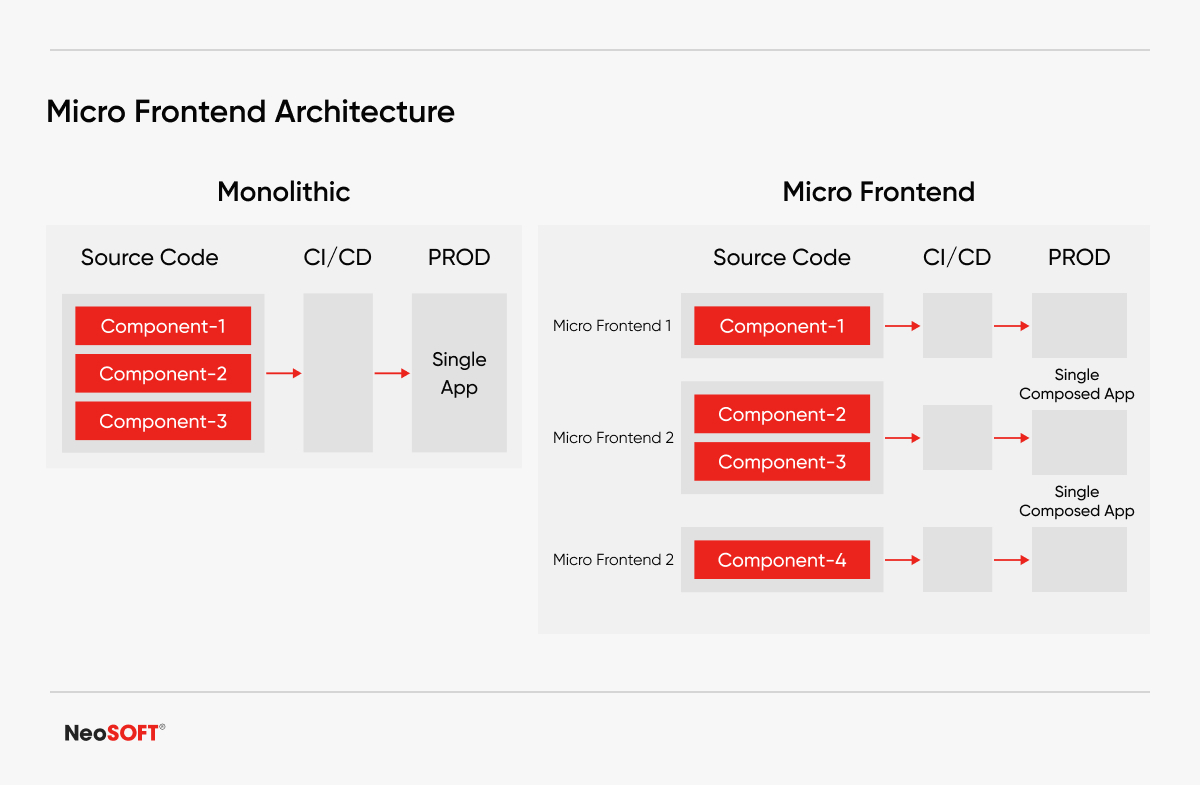Building Micro Frontends for Agile Development
What are Micro Frontends?
Micro Frontends are revolutionizing the traditional approach to building, deploying, delivering, and maintaining web applications. In the conventional model, these tasks required large-scale developer teams and complex, centralized systems. However, the rise of Micro Frontends is changing the game. This innovative design approach involves breaking down a front-end app into individual, semi-independent “micro apps” that collaborate loosely, much like microservices.
By adopting this new technique, organizations can achieve significant benefits. Firstly, it enables the decoupling of large teams to empower smaller groups to develop strategies and make decisions autonomously on their projects.
Additionally, it offers several advantages:
- Reducing cross dependencies: Micro Frontends help minimize the dependencies between different teams or services, allowing them to work more independently and efficiently.
- Separating deployment plans for individual services/applications: With Micro Frontends, deployment plans can be tailored to each specific service or application, facilitating faster and more targeted releases.
- Splitting the front-end codebase into manageable pieces: By breaking the front-end codebase into smaller, more manageable pieces, developers can focus on specific functionalities or features without being overwhelmed by the entire codebase.
Organizations can supercharge speed, ignite innovation, and ensure fail-safe operations with Micro Frontends. Centralization often leads to team frustrations, as external dependencies become challenging to resolve, given that one team’s work can heavily impact another’s. Micro frontends address this issue by promoting autonomy and reducing interdependencies.
Architecture Of Micro Frontend: Say Goodbye to Monoliths!
Addressing codebase growth with Micro Frontends: As the product expands, the codebase grows in complexity, necessitating delegating different features to separate teams.
However, when multiple teams consistently work on the same monolithic codebase, it often leads to conflicts and delays in the CI/CD pipeline. To mitigate these challenges, breaking down the monolithic architecture into Micro Frontends empowers individual teams to take ownership of feature development and appropriately leverage the framework for their specific product requirements.
Unlike microservices, there is no standardized approach or architecture for Micro Frontends. We have adopted a Single Page Application (SPA) Micro Frontend architecture, which ensures scalability within a distributed development environment.
The diagram provides an overview of the Micro Frontend architecture, showcasing the relationship between Micro Frontend source control, deployment through the CI/CD pipeline, and the host app consisting of Micro Frontend services:
Our host app integrates Micro frontend applications within their codebases, servers, and CI/CD pipelines. These mini-apps are divided based on routes, allowing our DevOps team to efficiently build and continuously deploy various feature updates to the production environment without impacting the entire product.
When breaking down the application, we follow a value-driven approach, ensuring that each mini-app delivers value on its own. This approach allows for greater flexibility and targeted development efforts within the micro frontend architecture.
What are the benefits of Micro Frontends?
By leveraging the appropriate tools and components, any team can surpass the challenges of monolithic applications and simplify them into individual release features. The fear of unintended consequences causing application breakdown becomes obsolete. Independent groups can collaborate seamlessly, focusing on distinct front-end features and developing them comprehensively, from the database to the user interface. Micro Frontends enable the following possibilities:
- Facilitate autonomous teamwork: Each team can concentrate on their specific part of the project without extensive coordination or dependency on other groups.
- Build independent applications: Micro Frontends allow the creation of self-contained applications that operate without relying on shared variables or runtime, even if multiple teams employ the same framework or codebase.
- Enhance versatility: With teams working independently, there is greater flexibility in exploring diverse ideas and designs.
- Develop cross-team APIs: Micro frontends encourage native browsers for communication and enable the creation of APIs across different teams.
- Flexible updates and upgrades: The user-centric nature of Micro Frontends streamlines the process of releasing new updates, making it more efficient, quicker, and responsive.
- Decrease codebase complexity: By clearly defining the goals of each component within an application, the codebase becomes cleaner and easier to work with, often avoiding problematic coupling between components that can occur otherwise.
- Implement autonomous deployment: Micro Frontends support continuous delivery pipelines, where teams can independently build, test, and deploy their code without worrying about the status of other code within the application.
- Scalability and extensibility: Micro frontends, developed in smaller units, provide developers with better control over their projects, allowing for more effortless scalability and the ability to toggle features on and off to manage complexity effectively.
- Embrace the single responsibility principle: Each module in Micro Frontends adheres to the principle of having a single responsibility, contributing to cleaner and more maintainable code.
- Improve user experience: With the independence of cross-functional teams, every aspect of the user experience and application can be meticulously thought through, resulting in an enhanced user experience.
Micro Frontends herald a paradigm shift in software development, granting teams the autonomy to work independently. Promoting efficient development practices enables streamlined workflows and faster iteration cycles. This approach ultimately leads to improved user experiences and more manageable applications. With Micro Frontends, organizations can embrace a modular architecture that empowers teams, fuels innovation, and enhances productivity.
Challenges with Micro Frontends
While Micro Frontends offer numerous advantages, specific issues need to be considered and addressed:
- Increased code duplication and framework complexity: Each team can choose their technologies, and the browser may download multiple frameworks and duplicate code to impact performance and improve the overall complexity of the application.
- Balancing autonomy and shared dependencies: There is a tension between allowing teams to independently compile their applications and the desire to have common dependencies for efficient code reuse. However, introducing changes to shared dependencies may require additional efforts to accommodate one-off releases.
- Consideration of the development environment: When developing Micro Frontends in a non-production-like climate, it becomes essential to regularly integrate and deploy them to environments that closely resemble the production environment. Additionally, thorough testing, both manual and automated, in these production-like environments is crucial to identify and address integration issues as early as possible.
Leveraging Micro Frontends to address complex codebases
Micro Frontends offer a valuable solution for tackling complex codebases and scaling architectures. They serve as an effective component model, providing a modular approach to application development, streamlining development processes, and facilitating faster project delivery. While numerous solutions are available in the market, it’s crucial to consider the variety of patterns and carefully evaluate factors such as team size and communication between components and frameworks.
By adopting Micro Frontends, organizations can develop targeted solutions for specific challenges within their applications. Transforming an extensive front-end application into a Micro Frontend architecture can significantly reduce technical friction and enhance overall efficiency.
Mastering Micro Frontends
Enter Micro Frontends – a game-changing architectural pattern that allows for the independent development and deployment of smaller, self-contained frontend modules. With Micro Frontends, teams can effectively decouple their front-end codebase, enabling seamless collaboration, faster development cycles, and improved scalability. This approach opens possibilities, empowering organizations to create highly modular, maintainable, and adaptable web applications. As we embark on this exciting journey, let’s delve into the road ahead for Micro Frontends and discover its boundless potential for the future of front-end development.
By Sumit Munot (Delivery Manager – Javascript Fullstack, NeoSOFT)







